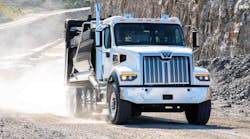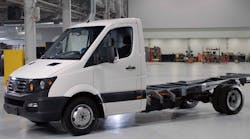The first new Peterbilt medium-duty cabover Model 220 – featuring numerous enhancements to performance, durability and the operating environment – rolled off the assembly line at the company’s COE manufacturing facility in Mexicali, Mexico.
The Class 6 and 7 truck, which was introduced earlier this year during the Mid-America Trucking Show, is now in full production.
“The new Model 220 brings customers greater levels of productivity. Drivers will enjoy enhanced maneuverability that shortens the curb-to-curb turning radius by 30 percent and the new, standard electronic braking system (EBS) for improved braking performance,” said Robert Woodall, Peterbilt Director of Sales and Marketing. “These characteristics combine with an efficient bumper-to-bumper length of 35 feet for added agility while still delivering an extra 45 inches of payload area and a frame rail system that can be upfitted with bodies ranging from 16 to 28 feet.
“It is extremely versatile and will exceed expectations in every application, from urban pick-up-and delivery to refuse, and from landscaping to street sweeping and striping.”
The cab features a completely redesigned interior that was engineered to give operators unparalleled levels of safety, productivity and comfort.
“Maximizing visibility was a key consideration in designing the Model 220,” said Landon Sproull, Peterbilt Chief Engineer. “Our 2,500-square-inch windshield, large side windows and multiple-mirror array provides operators with a panoramic view, helping them navigate the confined and congested areas that these vehicles often operate in.”
The new curved dashboard features easy-to-read instrumentation and an interactive, 5-inch color display module that provides information on vehicle and driver performance.
“The Driver Information Center display in the Model 220 keeps operators abreast of all vital vehicle and engine functions,” said Sproull. “The multi-language system features advice for the operator on ways to improve in areas such as increasing fuel efficiency and reducing brake wear by modifying driving behavior.”
Ergonomics was a primary focus in designing the interior, Sproull said, resulting in easier-to-read instrumentation and grouping all switches by function. Everything is within easy reach of the driver and the overall layout provides a logical, easy-to-operate environment.
He added that storage is abundant in the new cab with compartments in the door panels, along the back wall, in the header and on the dash, conveniently located near the driver for paperwork or other items. Additionally, a spacious, lockable compartment with two integrated cup holders that fits along the engine tunnel area is optional.
The Model 220 will remain standard with numerous driver-pleasing features, including: power windows and mirrors; air-ride driver’s seat; and air conditioning. It is also available with a passenger-side air-ride seat or fixed two-man bench to accommodate three people in the cab.
Model 220s are now standard with electronic braking systems for improved braking performance and faster response from the pedal to the brakes.
The Model 220 is equipped with the PACCAR PX-7 Engine with up to 260 horsepower and 520 lb.-ft. of torque. The standard automatic Allison transmission has a push-button shifter for easy engagement.








